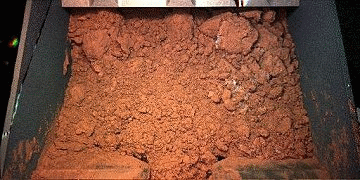| FLYBY ALERT! Space shuttle Discovery launched on May 31st. Get your flyby alerts from Space Weather PHONE | | | ASTEROID FLYBY: Today, asteroid 2008 KT is flying past Earth only three times farther away than the Moon. To students of ancient history, any asteroid named "KT" may sound a little scary. But unlike the 10-km-wide killer that crashed into Earth at the K-T boundary 65 million years ago, modern-day asteroid 2008 KT is a pipsqueak less than 10 meters wide. If it hit Earth, it would disintegrate in the atmosphere, producing at most a harmless fireball and a scattering of meteorites on the ground. Our dinosaurs are safe for another day. A SCOOP OF MARS: Yesterday, Phoenix's 7.7-foot robotic arm reached out and took its first scoop of Mars. A camera attached to the arm snapped this picture of the harvest: 
Note the bright white material highlighting the red crumbly soil. "We don't know what this material is yet," says University of Arizona's Pat Woida, a senior engineer on the Phoenix team. It could be "ice, a salt or something new." This first scoop was just a test, a light workout for the newly extended arm, and the contents were dumped back onto the ground. Soon, however, similar samples will be drawn inside the lander for analysis by microscopes, electrical and thermal probes, a mass spectrometer and a wet chemistry lab. The mystery material may yet be known. Stay tuned for updates. 3D BONUS: Like a human being, Phoenix's stereo camera has a right and left eye for seeing things in three dimensions. Using images from the two points of view, graphic artist Patrick Vantuyne of Belgium has created some superb anaglyphs of the lander's surroundings. Put on your 3D glasses and behold: Mars Yeti (Phoenix's arm makes a first impression on the Red Planet); One small step... (one of the lander's three feet); Vines (the camera's mast casts a criss-crossed shadow on the ground). SPACE STATION TRANSIT: Consider it a habit. Whenever the International Space Station passes in front of the sun over Maine, local astronomer John Stetson always photographs the transit. It happened again just yesterday. This time, however, Stetson noticed something different. "The station's silhouette seemed a bit larger than usual." (continued below) 
That's because space shuttle Discovery is visiting the station and adding to its outline. Discovery docked to the ISS on June 2nd and astronauts are already hard at work installing a pressurized chamber as large as a tour bus. The new module, hauled to orbit in the shuttle's cargo bay, is the centerpiece of Japan's Kibo science laboratory. Space station transits of the sun are fleeting and impossible to see with the unaided eye. Stetson used a Coronado solar filter to reduce the glare and record yesterday's passage. On the other hand, space station transits of the night sky require no special equipment to observe. The ISS glides slowly across the celestial sphere as bright and beautiful as Venus herself. Try our simple Satellite Tracker to find out when to look. more images: from Tom Wagner of Waterloo, Iowa; from Roy Schmidt of Chelsea, Michigan; from AnnMarie Lidman of Merrimack, NH; from Marian Urbanik of Cadca, Slovak Republic; from Milan Antoš of Jablonec nad Nisou, Czech Republic; from Tamas Ladanyi of Veszprem, Hungary; from Michael Boschat of Halifax, Nova Scotia;
May 2008 Aurora Gallery
[Aurora Alerts] [Night-sky Cameras] | 
